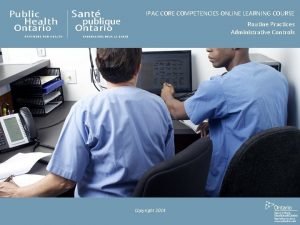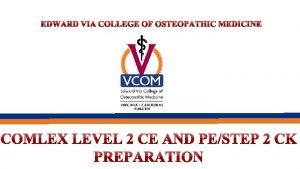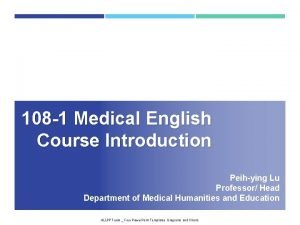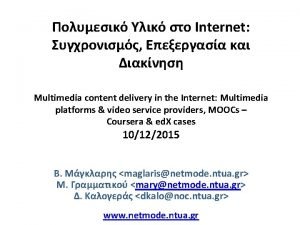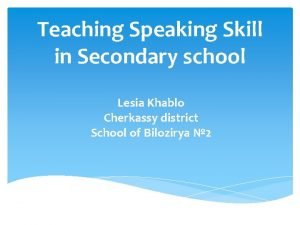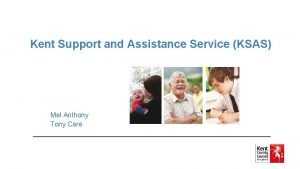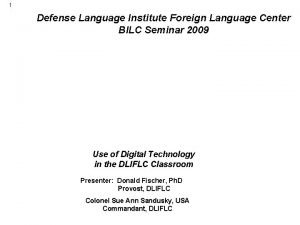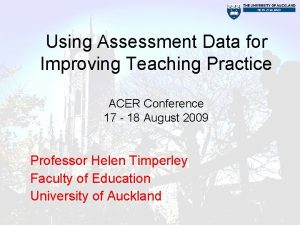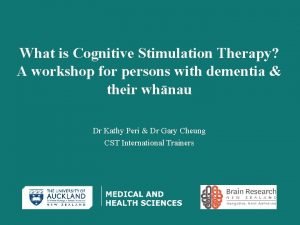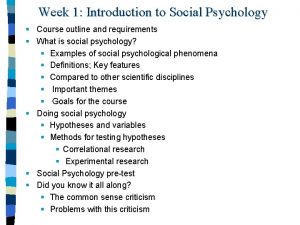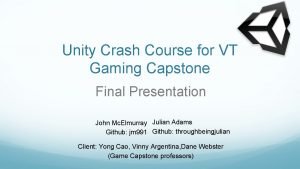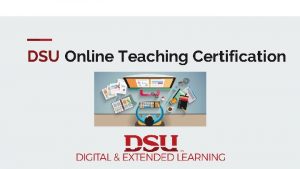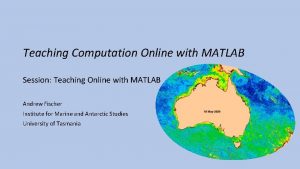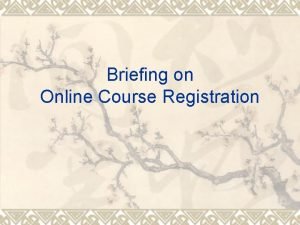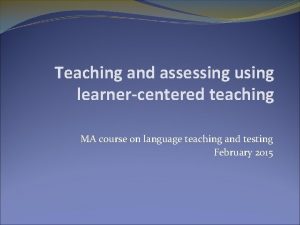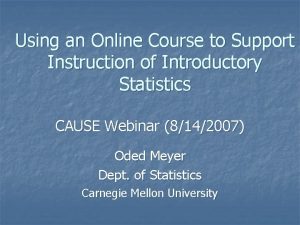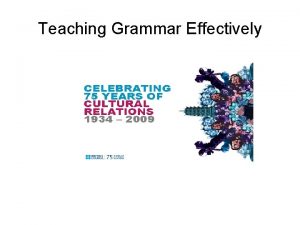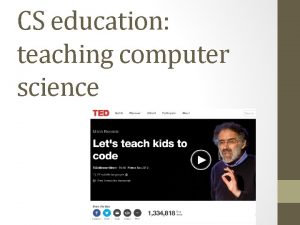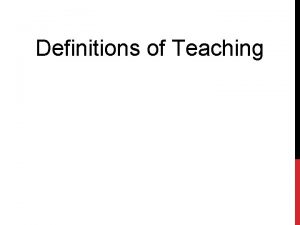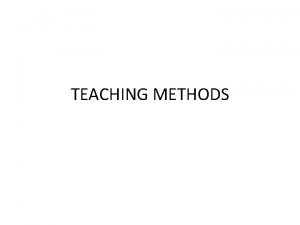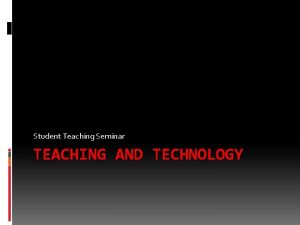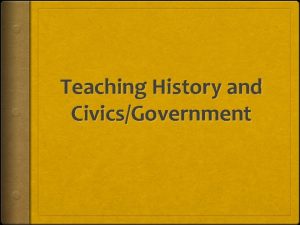Using an Online Course to Support Teaching of











































- Slides: 43

Using an Online Course to Support Teaching of Introductory Statistics: Experiences and Assessments e. COTS 2012 Oded Meyer Candace Thille Marsha Lovett Carnegie Mellon University


The Effort: Carnegie Mellon’s Open Learning Initiative (OLI) Scientificallybased online courses and course materials that enact instruction, support instructors, and designed to improve the quality of higher education.

The OLI Statistics Course

Educational Mission of Funder (The William and Flora Hewlett Foundation) Provide open access to high quality post-secondary education and educational materials to those who otherwise would be excluded due to: – Geographical constraints – Financial difficulties – Social barriers To meet this goal: – A complete stand-alone web-based introductory statistics course. – openly and freely available to individual learners online.

Key Feature of the OLI Statistics Course High level of scaffolding in the course structure: • The course is based on the “Big Picture” of Statistics • Rigid structure throughout the material hierarchy • Smooth conceptual path

Results… Students using the OLI statistics course demonstrated learning outcomes equal to or better than the traditional class, in half the time. Six months later, the students who used the OLI statistics course had retained the material just as well as the traditional class. Imagine the following hypothetical scenario…

Key Features of the OLI Statistics course • Immediate and Targeted Feedback - Studies: immediate feedback students achieve desired level of performance faster. - Throughout the course immediate and tailored feedback is given. • mini tutors embedded in the material. • self assessments activities (Did I get this? )

Key Features of the OLI Statistics course • Feedback to the instructor about students’ learning Learning Dashboard - Presents the instructor with a measure of student learning for each learning objective. - More detailed information: • Class’s learning of sub-objectives • Learning of individual students • Common misconceptions

Learning Dashboard Team led by Dr. Marsha Lovett




Learning activities are instrumented to continuously assess student learning Feedback to Student Feedback to Instructor

Learning activities are instrumented to continuously assess student learning Feedback to Student Feedback to Instructor

The Key…. Feedback Loops




Accelerated Learning Hypothesis: With the OLI statistics course, students can learn the same material as they would in a traditional course in shorter time and still show equal or better learning.

Three Accelerated Learning Studies #1 Small class, expert instructor (2007) #2 Replication with larger class (2009) – With retention follow-up 4+ months later #3 Replication with new instructor (2010) – Experienced statistics instructor – New to OLI Statistics course and hybrid mode

Study 1: Method ~180 students enrolled 68 volunteers for special section 24 students, adaptive/ accelerated condition 44 students, traditional control condition

Adaptive/Accelerated vs. Traditional Two 50 -minute classes/wk Eight weeks of instruction Homework: complete OLI activities on a schedule Tests: Three in-class exams, final exam, and CAOS test < < ? Four 50 -minute classes/wk = Tests: Three in-class exams, final exam, and CAOS test Fifteen weeks of instruction Homework: read textbook & complete problem sets Same content but different kind of instruction

Dependent Measure CAOS = Comprehensive Assessment of Outcomes in a First Statistics course (del. Mas, Garfield, Ooms, Chance, 2006) – Forty multiple-choice items measuring students’ “conceptual understanding of important statistical ideas” – Content validity – positive evaluation by 18 content experts – Reliability – high internal consistency – Aligned with content of course (both sections) – Administered as a pre/posttest

Study 1: CAOS Test Results Chance Adaptive/Accelerated group gained more (18% vs 3%)pre/post on CAOS than did Traditional Control, p <. 01.

Brief Time-Log Study • • Students in both groups recruited to complete time-logs Self-report for both groups Analogous point in the course (2/3 through) Six consecutive days: Wednesday - Monday

Study 1: Time Spent Outside of Class No significant difference between groups in the time students spent on Statistics outside of class

Study 2: Replication & Extension • Same method, same procedure, same instructor • Larger class (52 students in Adaptive / Accelerated) • Follow-up study conducted 4+ months later – Retention – Transfer

Study 2: CAOS Test Results Chance Adaptive/Accelerated group gained more pre/post on CAOS than did Traditional Control, p <. 01.

Study 2: Follow-up study Goal: study retention, transfer, and preparation for future learning Follow-up Begins Trad’l Ends Adapt/Acc Ends Jan Feb Mar Apr May Jun Jul Aug Sep Oct Adapt/Acc Delay (13 Students) Trad Delay (14 Students) Students recruited from both groups at the beginning of the semester following the main study

Study 2, Retention: Re-taking CAOS Chance At 6 -month delay, Adaptive/Accelerated group scored higher on CAOS than Traditional Control, p <. 01.

Study 2, Transfer: Data-Analysis Problem A weather modification experiment was conducted to investigate whether “seeding” clouds with silver nitrate would increase the amount of rainfall. Clouds were randomly assigned to the treatment group (to be seeded) or to the control group (not to be seeded), and data were collected on the total rain volume falling from each cloud. <data> Does cloud seeding increase rainfall? Students’ chosen analyses recorded and scored [0 -3] Scoring was blind to student condition

Study 2, Transfer: Data-Analysis Problem Adaptive/Accelerated group scored higher than Traditional Control, p <. 05.

Study 3: Further Replication & Extension • Same method, same procedure • New instructor • Not involved in development of OLI course • New to OLI statistics and hybrid teaching mode • Instructor held constant for both Adapt/Acc and Control conditions • Larger class (40 students in Adaptive / Accelerated)

Study 3: CAOS Test Results Chance Adaptive/Accelerated group gained more pre/post on CAOS than did Traditional Control, p <. 01.

To Summarize… With the OLI Statistics course, the Accelerated students: • Completed the course in half as many weeks with half as many class meetings per week • Spent the same amount of time in a given week on coursework outside of class as traditional students • Gained much more on the CAOS test than did the traditional controls • Retained their knowledge and maintained an advantage over traditional students in retention tests given 1+ semesters later.

Community of Use This semester, the OLI statistics course is used by a diverse groups of 54 institutions (total of 5060 students) • Liberal Arts Colleges (Wesleyan University, Grinnell College) • Community Colleges (Nassau Community College, Santa Ana College) • High schools (Winchester Thurston School) • International (Singapore Management University) • State Schools (UC San Diego, University of Illinois Chicago)

Instructors’ Experiences “Using OLI, we’ve developed what we think is a really innovative, inquiry-based approach to teaching stats” “ There is generally a third of the class that hates statistics and doesn’t want to be there. Before [I used OLI], I didn’t know who those students were or how to support them” “ The software not only taught procedures but helped students understand their possible applications. It answers the ‘Why do I care? ’ question”

Instructors’ Experiences “As an adjunct math professor, I was able to jump into a brand new course at my college ONLY because I had access to OLI materials” “The learning curve is sharp and managing the resources was difficult at first but having access to what students are really learning and not is excellent…. . Great for both instructors and students have access to the ‘truth’ and not just the perceived truth about the learning. This has given me an opportunity to grow as an instructor out of my usual comfort zone”

Students’ Experiences: • End of the course survey: 85% Definitely Recommend 15% Probably Recommend 0% Probably not Recommend 0% Definitely not Recommend Student Quote: "This is so much better than reading a textbook or listening to a lecture! My mind didn’t wander, and I was not bored while doing the lessons. I actually learned something. “

Adaptation Projects • CC-OLI (Community College OLI) • Statway (Statistics Pathway) (The Carnegie Foundation for the Advancement of Teaching) • University of Maryland University College Business School • Georgetown University School of Foreign Service

“Improvement in postsecondary education will require converting teaching from a ‘solo sport’ to a community-based research activity” Herbert Simon, Last Lecture Series, Carnegie Mellon, 1998

Contact Information Oded Meyer: ogm@georgetown. edu Collaborators: Marsha Lovett (Cognitive Scientist, Learning Dashboard developer): lovett@cmu. edu Candace Thille (OLI Project Manager): cthille@cmu. edu To access the course: www. cmu. edu/oli
 One and a half brick wall
One and a half brick wall Course title and course number
Course title and course number Course interne moyenne externe
Course interne moyenne externe What is scaled down teaching
What is scaled down teaching Remedial activities for slow learners
Remedial activities for slow learners Supporting details major and minor
Supporting details major and minor Dan boneh cryptography 2
Dan boneh cryptography 2 Supplemental online coursework
Supplemental online coursework Ipac core competencies
Ipac core competencies Online cryptography course
Online cryptography course Marksmanship instructor
Marksmanship instructor Ptit safe driving and awareness course
Ptit safe driving and awareness course Comquest vs combank
Comquest vs combank Medical english online course
Medical english online course Fmcsa north american standard level i course online
Fmcsa north american standard level i course online Jrotc marksmanship instructor course online
Jrotc marksmanship instructor course online Internetmultimedia org live stream
Internetmultimedia org live stream Chandler online academy access my course
Chandler online academy access my course African american beauty academy
African american beauty academy 10 principles of effective online teaching
10 principles of effective online teaching Swinburne online teaching
Swinburne online teaching Poem on online teaching
Poem on online teaching Lesia pronunciation
Lesia pronunciation Kent support and assistance service
Kent support and assistance service Global language online support system
Global language online support system Gloss global language
Gloss global language Using assessment data for improving teaching practice
Using assessment data for improving teaching practice Advantages and disadvantages presentation
Advantages and disadvantages presentation Using system using system.collections.generic
Using system using system.collections.generic Accumulator ac
Accumulator ac Young workers readiness certificate
Young workers readiness certificate Alabama hunters education
Alabama hunters education Cognitive stimulation therapy training course
Cognitive stimulation therapy training course Exhibition management course
Exhibition management course Powerschool waukee
Powerschool waukee Interlake course catalog
Interlake course catalog Dpmi course details
Dpmi course details Banff pathology course
Banff pathology course Sociocultural psychology examples
Sociocultural psychology examples Lymphatic of upper limb
Lymphatic of upper limb Molecular biology crash course
Molecular biology crash course Ppm university of pretoria
Ppm university of pretoria Unity over the shoulder camera
Unity over the shoulder camera Sbu bio major
Sbu bio major








